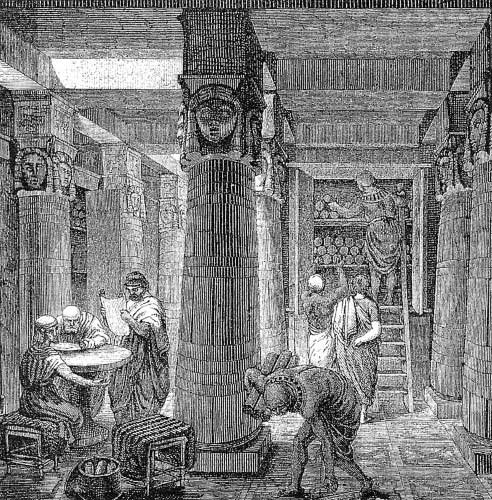The famous Alexandrian Library is a repository of ancient knowledge.
According to legend, the library was founded in the 3rd century BC and was destroyed towards the end of the Roman period, containing up to millions of indexed documents. Researchers are still wondering if this library really existed and when it was destroyed.
The birth of the great library
Alexander the Great (356 – 323 BC) is famous for building a vast empire in just over a decade, from his succession to the Macedonian throne in 336 BC until his untimely death in 323 BC. Alexander’s lasting legacy comes from the dozens of cities he founded, including some fifteen cities called Alexandria.
But there was no city more important than Egyptian Alexandria, founded in 330 BC. Alexandria is a land located west of the Nile Delta, close to the fishing village of Rhakotis, a thriving new city that surprises visitors with its wealth.
Designed by the architect Dinocrates of Alexander, Alexandria is distinguished by its massive architecture, its large port, its Pharos lighthouse, its museum and above all the large library, once considered the intellectual capital of the world.
As a world famous city-state, Alexandria is influenced by the language, culture and political orientation of Greece, but its population is global. The Greeks coexisted with the Egyptians, the Persians, the Jews, the Indians and finally the Romans.
The first textual evidence of great librarianship comes from the Aristeas library in the 2nd century BC. However, some historians consider this text to be a false source, allegedly written by a court official of Ptolemy II Philadelphus (309 – 246 BC).
Later Roman authors Strabo and Plutarch established the library’s origins during the reign of Ptolemy ISoter. Plutarch writes about Demetrius of Athens, who was exiled, proposed to build a museum, or temple to the gods of the Muses, and its accompanying library at the palace of Ptolemy I in Alexandria. Ptolemy I wanted to codify the diary and the personal history of Alexander the Great, his general.
Demetrius’ plan was a solution to this goal. At the end of his reign, Ptolemy I would have gathered more than 50,000 texts which were in disorder in the halls of the palace and constituted the main part of the archives proposed by Demetrius.
Ptolemy III Eugertes (280 – 222 BC) continued the work of building the large library, expanding the collections. According to documents, he sent people across the Mediterranean to search bookstores, looking for prints of classical works.
Even before Ptolemy III enlarged the collection, a second or sub-library had been established, possibly at the Serapis Temple, to accommodate the ever-growing collection. Personal libraries were common in the ancient world, but the public library, especially on the ambitious scale of Alexandria, was an innovation. Like a university, the Alexandria Museum and Libraries are the archives of books and the workplaces of academics.
The greatest librarian of Alexandria was the poet Callimachus of Cyrene (310 – 240 BC). He renovated the table of contents, made up of 120 separate volumes, recording eight types of documents kept in Alexandria. Categories, which Callimachus calls Pinakes, or lists, include profile and folder details by source.
His work is said to include references to all known classical literary works of his time. Additionally, it also sorts library materials by genre and then alphabetically.
How was the library destroyed?
The large library suffered a series of accidents or was intentionally destroyed. Julius Caesar is often blamed for the first library fire. After his victory at the Battle of Pharsalia in 48 BC, Julius Caesar pursued his once defeated adversary, Pompey Magnus, to Egypt. Caesar arrived in Alexandria at the time of the civil war between the young king Ptolemy XIII (62 – 47 BC) and his sister Cleopatra VII (69-30 BC).
 The 19th century painter, O. Von Corven, presented the work of the Library of Alexandria from archaeological evidence.
The 19th century painter, O. Von Corven, presented the work of the Library of Alexandria from archaeological evidence.
While in Egypt, Ptolemy XIII’s forces surrounded Caesar and his troops in the port of Alexandria. Caesar ordered his forces to set fire to Ptolemy XIII’s fleet. But the summer winds spread the fire from the port to the warehouse and possibly into the city.
Plutarch reports in The life of Caesar in the 2nd century AD the burning of part of the library’s property, perhaps the shipyard but also the large library itself. Historians wonder if this fire, if it happened, was purely accidental or if Caesar deliberately removed the library.
As the intellectual capital of Egypt, Alexandria prides itself on a wealthy and intelligent population. Until AD 391, an Alexandrian riot centered on the temple of Serapis, Serapeum, could have resulted in the burning of the sub-library and the great library.
The construction of a new library in Alexandria in 2002 is a “spiritual legacy” from the old knowledge base. Although no longer present, the great library of ancient Alexandria remains an intellectual wonder of the world and a source of inspiration for future generations.
The Library of Alexandria is considered a reference site of unprecedented magnitude. It is estimated that the large library has collections of 40,000 parchments to 1,000,000 texts. Parchments, instead of books, are the typical text format. Several papyrus scrolls can include a book or a volume, which could explain this statistical difference.


